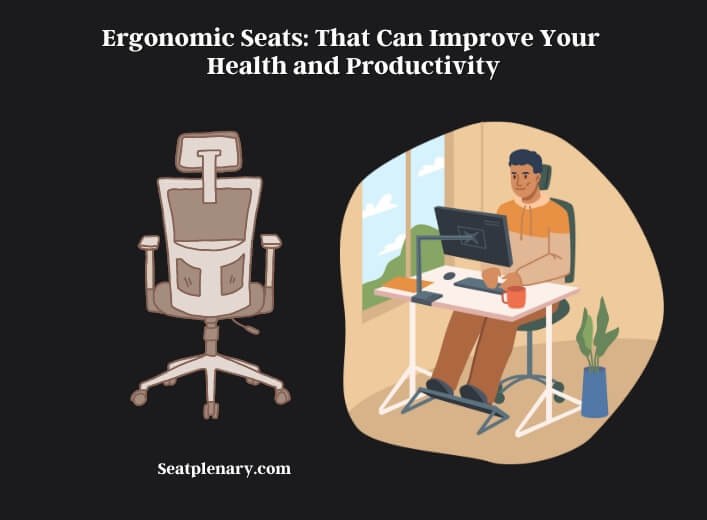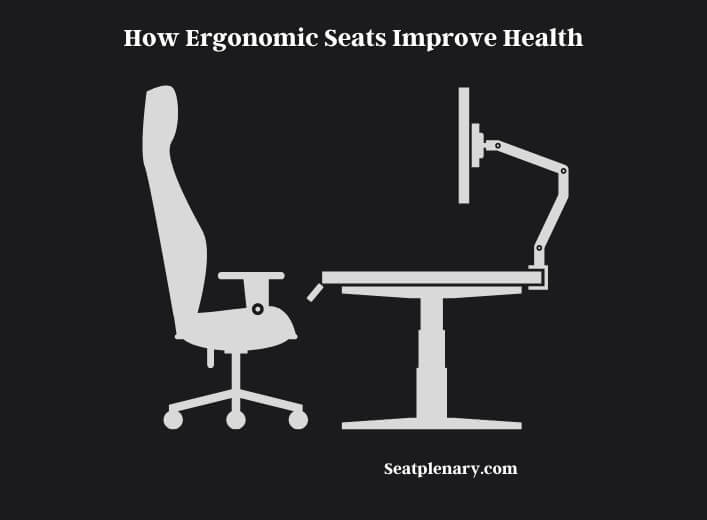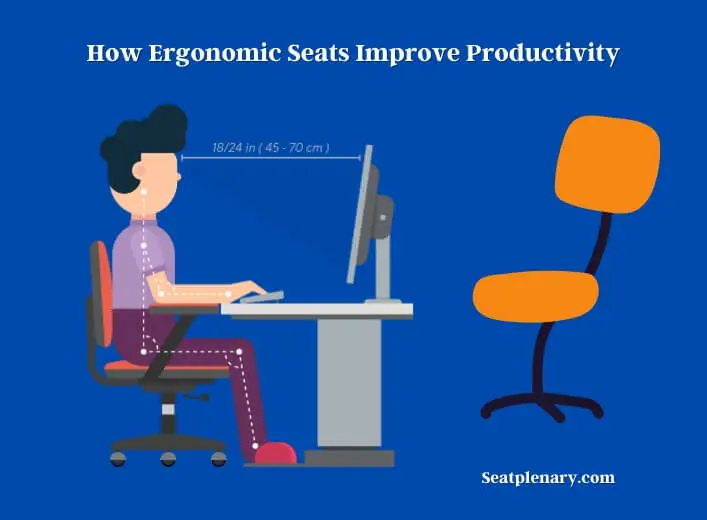In today’s world, where many people spend a significant amount of time sitting at a desk, it is essential to consider the impact that our seating arrangement can have on our health and productivity. This is where ergonomic seats come in. Ergonomic seats are designed to support the body and promote proper posture, reducing the strain on muscles and joints that can lead to pain, discomfort, and even injury. By using ergonomic seats, we can create a comfortable and safe environment that allows us to focus on our work without experiencing any discomfort.

The importance of ergonomic seats has been recognized by researchers, healthcare professionals, and workplace safety experts. Studies have shown that the use of ergonomic seats can reduce the risk of developing musculoskeletal disorders, which are among the most common occupational health problems. Ergonomic seats can improve productivity by reducing fatigue and discomfort, allowing employees to work more efficiently and effectively.
What are Ergonomic Seats
Ergonomic seats are designed to support the body in a way that promotes proper posture and reduces the risk of developing musculoskeletal disorders. Unlike traditional seats that offer little to no support for the back, neck, or arms, ergonomic seats are designed to minimize discomfort and fatigue by reducing the strain on muscles and joints.
Ergonomic seats come in various shapes and sizes, but they all share a common goal of providing maximum comfort and support. Many ergonomic seats are adjustable, allowing users to customize the seat’s height, tilt, and lumbar support to fit their unique needs.
One of the key features of ergonomic seats is their ability to promote proper posture. Ergonomic seats are designed to keep the spine in a neutral position, reducing the pressure on the discs in the spine and preventing back pain. Additionally, ergonomic seats can help to reduce tension in the neck and shoulders, which can lead to headaches and other discomforts.
Ergonomic seats can be found in a variety of settings, including offices, schools, healthcare facilities, and even homes. They are an important investment for anyone who spends a significant amount of time sitting, as they can improve both comfort and productivity while reducing the risk of developing health issues associated with extended periods of sitting.
How Ergonomic Seats Improve Health
Extended periods of sitting can take a toll on the body, leading to a range of health issues such as back pain, neck pain, and carpal tunnel syndrome. Ergonomic seats are designed to reduce the risk of these health problems by promoting proper posture and reducing the strain on muscles and joints.

One of the key ways in which ergonomic seats improve health is by promoting proper spinal alignment. When sitting for long periods, it is easy to fall into a slouched position, which can put pressure on the spinal discs and lead to back pain. Ergonomic seats are designed to keep the spine in a neutral position, which reduces the pressure on the discs and helps to prevent back pain.
Ergonomic seats can also reduce tension in the neck and shoulders, which can lead to headaches and other discomforts. By providing proper support for the head and neck, ergonomic seats can help to keep the spine in alignment and reduce tension in the upper body.
To reduce the risk of back pain and neck pain, ergonomic seats can also help to prevent carpal tunnel syndrome. This condition is caused by pressure on the median nerve in the wrist and can lead to numbness, tingling, and pain in the hands and fingers. Ergonomic seats with adjustable armrests can help to reduce the pressure on the wrists and prevent carpal tunnel syndrome.
Ergonomic seats can help to reduce fatigue and increase energy levels. When sitting in a traditional seat for an extended period, it is common to experience fatigue and discomfort, which can lead to decreased productivity. Ergonomic seats, on the other hand, are designed to reduce fatigue by providing proper support for the body, leading to increased energy and productivity.
Ergonomic seats are an important investment for anyone who spends a significant amount of time sitting. By promoting proper posture and reducing the risk of health issues associated with extended periods of sitting, ergonomic seats can help to improve overall health and well-being.
How Ergonomic Seats Improve Productivity
Ergonomic seats not only improve health but also have a positive impact on productivity. By reducing discomfort and fatigue, ergonomic seats can help individuals to work more efficiently and effectively. Here are some of the ways in which ergonomic seats can improve productivity:

Reducing Discomfort
When sitting in a traditional seat, it is common to experience discomfort and fatigue, which can lead to decreased productivity. Ergonomic seats are designed to reduce discomfort by providing proper support for the body, which can help individuals to focus on their work without any distractions.
Improving Posture
Poor posture can lead to discomfort and fatigue, which can negatively impact productivity. Ergonomic seats promote proper posture by keeping the spine in a neutral position, reducing the pressure on the spinal discs, and preventing back pain. Good posture also allows for better breathing, which can help individuals to feel more energized and alert.
Reducing Fatigue
Sitting for extended periods can lead to fatigue, which can decrease productivity. Ergonomic seats are designed to reduce fatigue by providing proper support for the body, allowing individuals to work for longer periods without feeling tired.
Improving Circulation
Sitting for long periods can lead to poor circulation, which can lead to discomfort and decreased productivity. Ergonomic seats with adjustable seat height and tilt can improve circulation by allowing individuals to adjust their seating position and promote better blood flow.
Enhancing Comfort
Ergonomic seats are designed to be comfortable, which can help individuals to focus on their work without any distractions. By reducing discomfort and fatigue, individuals are able to work more efficiently and effectively, leading to increased productivity.
Ergonomic seats are an important investment for anyone who wants to improve their productivity while reducing discomfort and the risk of health issues associated with extended periods of sitting. By promoting good posture, reducing fatigue, improving circulation, and enhancing comfort, ergonomic seats can help individuals to work more efficiently and effectively, leading to better overall productivity.
Types of Ergonomic Seats
There are several types of ergonomic seats available in the market, each with its unique features and benefits. Here are some of the most common types of ergonomic seats:
Ergonomic Office Chairs
These are the most common type of ergonomic seat and are designed for use in offices. They have adjustable features such as seat height, lumbar support, and armrests. They are designed to promote proper posture and reduce discomfort and fatigue, making them an excellent choice for anyone who spends a lot of time sitting at a desk.
Kneeling Chairs
These seats have a unique design that promotes an upright posture by tilting the pelvis forward. They are often used as an alternative to traditional office chairs and are popular among individuals who suffer from back pain or discomfort.
Ball Chairs
These seats are designed with a round, inflated ball instead of a traditional seat cushion. They require the active engagement of the core muscles to maintain balance, which can help to improve posture and reduce discomfort.
Saddle Chairs
These seats have a saddle-shaped design that promotes a natural, upright posture. They are often used in healthcare settings and are popular among individuals who suffer from back pain or discomfort.
Standing Desks
Standing desks are not technically seats, but they are a popular alternative to traditional desks and chairs. They allow individuals to work while standing, promoting better circulation and reducing the risk of health issues associated with extended periods of sitting.
Recliner Chairs
These seats are designed to provide support for the entire body, including the head, neck, and back. They are often used in healthcare settings and are popular among individuals who suffer from chronic pain or discomfort.
Tips for Using Ergonomic Seats
Using an ergonomic seat is just one part of promoting good posture and reducing discomfort while sitting. Here are some tips for using ergonomic seats effectively:
Adjust the seat height: Ensure that the seat is at a height where your feet can be flat on the ground and your knees are at a 90-degree angle. This helps to distribute your weight evenly and prevent pressure points.
Use lumbar support: If your chair has lumbar support, adjust it so that it supports the natural curve of your lower back. This can help to prevent lower back pain and discomfort.
Adjust the armrests: If your chair has armrests, adjust them so that your arms are at a 90-degree angle and your shoulders are relaxed. This can help to prevent shoulder and neck pain.
Take breaks: Even with an ergonomic seat, it’s important to take regular breaks from sitting. Stand up and stretch, walk around, or do some light exercise to help promote blood flow and prevent stiffness.
Use proper posture: Even with an ergonomic seat, it’s important to maintain proper posture. Keep your shoulders relaxed, sit up straight, and avoid slouching.
Use a footrest: If your feet can’t reach the ground comfortably, use a footrest to support your feet. This can help to prevent pressure points and promote better blood flow.
Use a cushion: If your chair doesn’t have enough cushioning, consider using a seat cushion to add some extra padding and reduce discomfort.
Conclusion
Ergonomic seats are an essential tool for promoting good posture and reducing discomfort and fatigue while sitting. With the increasing amount of time that individuals spend sitting, it’s more important than ever to invest in an ergonomic seat that can help to prevent health issues such as back pain, neck pain, and poor circulation.
Ergonomic seats come in various types, including office chairs, kneeling chairs, ball chairs, saddle chairs, standing desks, and recliner chairs. Choosing the right type of ergonomic seat will depend on your individual needs and preferences.
To make the most of your ergonomic seat, be sure to adjust it properly, take breaks, use proper posture, and use additional tools such as footrests or seat cushions if necessary. By following these tips and investing in an ergonomic seat, you can improve your health, productivity, and overall well-being while sitting.
